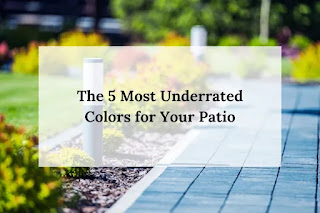Stamped Concrete Patios: Cost-Effective Alternatives to Natural Stone
Many of us like spending time outdoors and having a beautiful and functional space makes it easier to relax, entertain and enjoy our time outside. Natural stone patios have long been a popular choice for people who want to extend their living space outdoors. However, they can be expensive.
Fortunately, a stamped patio can offer the same effect as natural stone. Thanks to its availability and versatility, it can easily replicate different kinds of building materials so that you can enjoy a beautiful looking space.
Read our blog to find out why you should consider stamped concrete patios and why they are becoming popular among homeowners.
Aesthetic Appeal
Stamped patios are not only cost-effective, they are also visually stunning. As a versatile building material, concrete can mimic the appearance of various natural stones like slate, flagstone and cobblestone. This gives homeowners a wide range of design options.
Concrete has come a long way thanks to technological advancement. Aside from various stamping techniques, concrete can also be colored and textured so that it can be customized to complement your design or the overall style of your home and landscape.
Durability and Longevity
One of the key advantages of a concrete patio is its durability. Unlike natural stone, it won’t chip, crack or shift over time. Stamped patios are resistant to these issues and can withstand heavy foot traffic, extreme weather conditions and other outdoor elements without losing its strength and structural integrity.
A well maintained concrete patio can last for decades, making them a worthy investment for homeowners.
Low Installation and Maintenance Costs
Compared to natural stone patios, stamped concrete patios are more affordable in terms of installation and maintenance. This is because the materials needed to install a stamped patio is readily available and more affordable compared to natural stone options.
Installation of a concrete patio is also easier and straightforward which translates to reduced labor costs when compared to the intricate work involved when laying natural stone.
Maintenance is also easier and more affordable for stamped patios. They only require periodic cleaning and sealing to maintain their appearance and to protect against staining. Natural stones on the other hand require more frequent cleaning and repairs can be expensive if a stone is damaged or needs to be replaced.
Choosing a stamped concrete patio means that you enjoy a beautiful high quality outdoor space without the added financial burden.
Versatility in Design
One of the best things about concrete is its versatility. Concrete is open to a wide range of design options, from intricate patterns to various color choices. It is possible to create a wholly unique patio that suits your personal style and preferences.
Concrete can be made to look weathered, textured and even simulate the appearance of natural stone joints to give your patio a high-end and sophisticated look.
It can also be combined with other decorative elements like borders, stains and colors to further enhance its appeal. The versatility of stamped concrete allows homeowners to create a patio that seamlessly integrates with your current landscaping and complement the exterior features of your property.
Final Thoughts
Stamped concrete patios provide a cost-effective alternative to natural stone, offering homeowners a visually appealing and durable outdoor space. Thanks to its ability to replicate the look of various natural stones, stamped concrete patios provide versatile design options to suit different tastes and styles.
If you're looking to transform your outdoor space without breaking the bank, consider the affordability, beauty, and durability of stamped concrete patios. With the right design and professional installation, you can create a stunning patio that adds value to your home and enhances your outdoor living experience.



Comments
Post a Comment